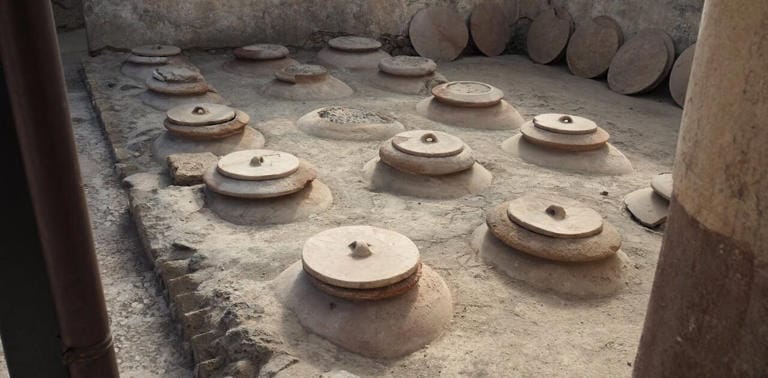
Exploring the nuances of Roman wine unlocks a fascinating aspect of ancient culture and culinary practice.
Wine in Ancient Rome was not merely a beverage, but a symbol of social status, an essential component of religious rites, and a daily necessity.
Unlike modern wine, which emphasizes purity and varietal character, Roman vintners employed a range of techniques to enhance the flavor and longevity of their wine.
Additives such as honey, herbs, and even seawater were common, resulting in a taste profile markedly different from what contemporary palates might expect.
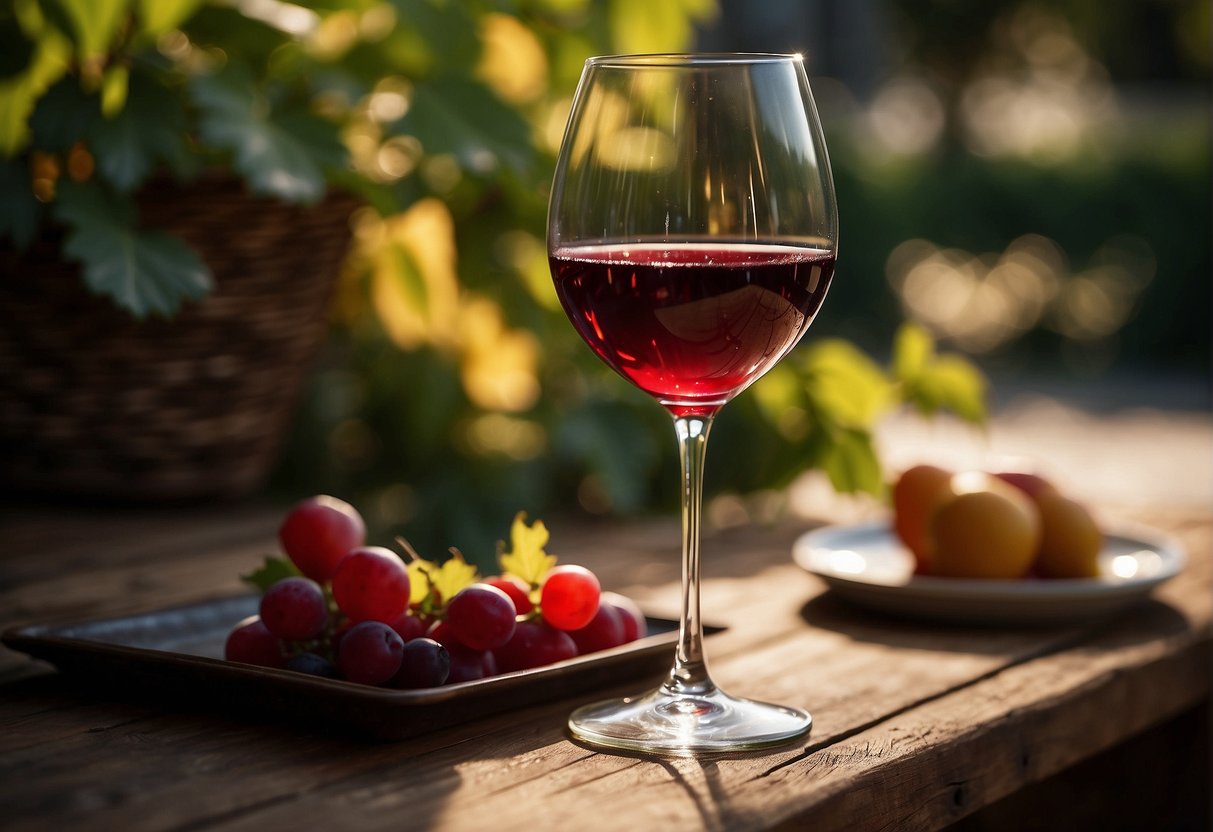
Given the lack of preserved samples, understanding the exact flavor profile of Roman wine relies on historical texts, archaeological findings, and the recreation of ancient recipes.
These sources suggest a diversity of wine styles, some sweetened for luxury, others fortified for medicinal purposes, and still others flavored with exotic spices to reflect the status of the consumer.
This varied palette of tastes reflects the sophistication of Roman viticulture and enology, and though it may differ from current preferences, it represents a rich tapestry of ancient innovation and taste.
Key Takeaways
- Roman wine was integral to social, religious, and daily life in Ancient Rome.
- Flavor enhancement techniques resulted in a diverse range of wine styles.
- Historical and archaeological sources guide our understanding of Roman wine’s flavor.
Historical Context of Roman Wine
In ancient Rome, wine played a pivotal role in culture and daily life, reflective of Italy’s enduring vineyard legacy.
The Romans elevated viticulture into an art form, with wine consumption permeating all social classes.
Pronounced vinum, this cherished beverage traced its roots through the Roman Empire, showcasing a society deeply intertwined with Bacchus, the god of wine.
Cultivation Practices The Romans advanced the cultivation of vines across their dominion, from the gustatory landscapes of Rome to the diverse terroirs of their vast territories.
They meticulously documented and implemented sophisticated practices, ensuring wine’s quality and variety.
Social Significance For ancient Romans, wine was central to social rituals, from public festivals to private banquets.
Unlike modern sensibilities, Roman wine usually had a higher level of viscosity and could be flavored with herbs or sweeteners. It was not just a drink but a symbol of prosperity and civilization.
- Classes of Wine
- Posca: A more acidic wine, diluted with water, often consumed by soldiers and the common populace.
- Falernian: A revered high-quality wine, enjoyed by the elite.
Wine Preservation Preserving wine in amphorae, Romans would sometimes seal the wine with olive oil or resin, which could also permeate the flavor profile.
The Roman palate favored wines that could taste markedly different from the fruity and less astringent wines of today.
Ritualistic Role In religious ceremonies, wine was integral to worship and offerings.
The average Roman might toast to Bacchus, hoping for good fortune and bountiful harvests, thereby cementing wine as both a divine and earthly delight.
Wine Production Techniques in Ancient Rome
Ancient Roman winemaking was a sophisticated process emphasizing grape quality and methodical aging.
Grape Harvesting and Selection
The initial step in ancient Roman winemaking was the meticulous harvesting and selection of grapes.
Workers carefully collected ripe grapes with a focus on ensuring only the finest quality went into production. This phase was crucial, as it determined the potential quality of the finished wine.
Fermentation Process
Once grapes were selected, Romans initiated the fermentation process.
They often used large clay vessels known as dolia or qvevri for fermenting wine.
These containers, typically lined up in the winery floors, provided a consistent, cool temperature necessary for fermentation.
Some were partially buried to better control the temperature, a key to successful fermentation.
Storage and Aging
After fermentation, storage and aging were of paramount importance in Roman winemaking.
Romans stored wine in dolia which could be sealed with lids to protect the contents from spoilage.
These large clay jars, with their porous nature, also allowed for a controlled interaction with air, which aided in the aging process and improved the flavor of the wines.
Proper storage in these vessels was crucial for the successful production and aging of wine in ancient Rome.
Roman Wine’s Flavor Profile
The flavor quality of Roman wine was a complex amalgamation, influenced by diverse ingredients, storage methods, and aging processes. These elements shaped the distinctive taste, aroma, and texture that would have characterized ancient wine experiences.
Influence of Ingredients
Roman wines were often enriched with additional ingredients to create unique flavors.
Historically, recipes suggested the use of varied additives like honey to enhance sweetness, sea water to impart a briny undertone, and a range of spices for spicy or aromatic complexity.
The inclusion of resin was not uncommon, possibly reminiscent of modern retsina, lending a distinct flavor profile that set these wines apart from contemporary varieties.
Role of Containers
The type of container in which wine was stored played a key role in its ultimate flavor.
Roman wines were stored in amphorae, which could impart subtle earthy notes to the wine.
These vessels were lined with various substances like pine resin, contributing to a unique taste and aroma.
Additionally, containers often sealed with gypsum or plaster altered the wine’s flavor due to chemical reactions over time.
Effects of Aging
Aging was crucial for Roman wine, influencing both flavor and texture.
Aging could intensify flavors like that of roasted walnuts or apples and enhance the wine’s overall balance.
Sotolon, a compound known for its potent, sweet, and nutty aroma, could also develop in aged wines, adding a sophisticated layer to the flavor palette.
The texture could evolve to be richer or silkier with time, contributing to a more luxurious mouthfeel.
Comparative Analysis with Modern Wines
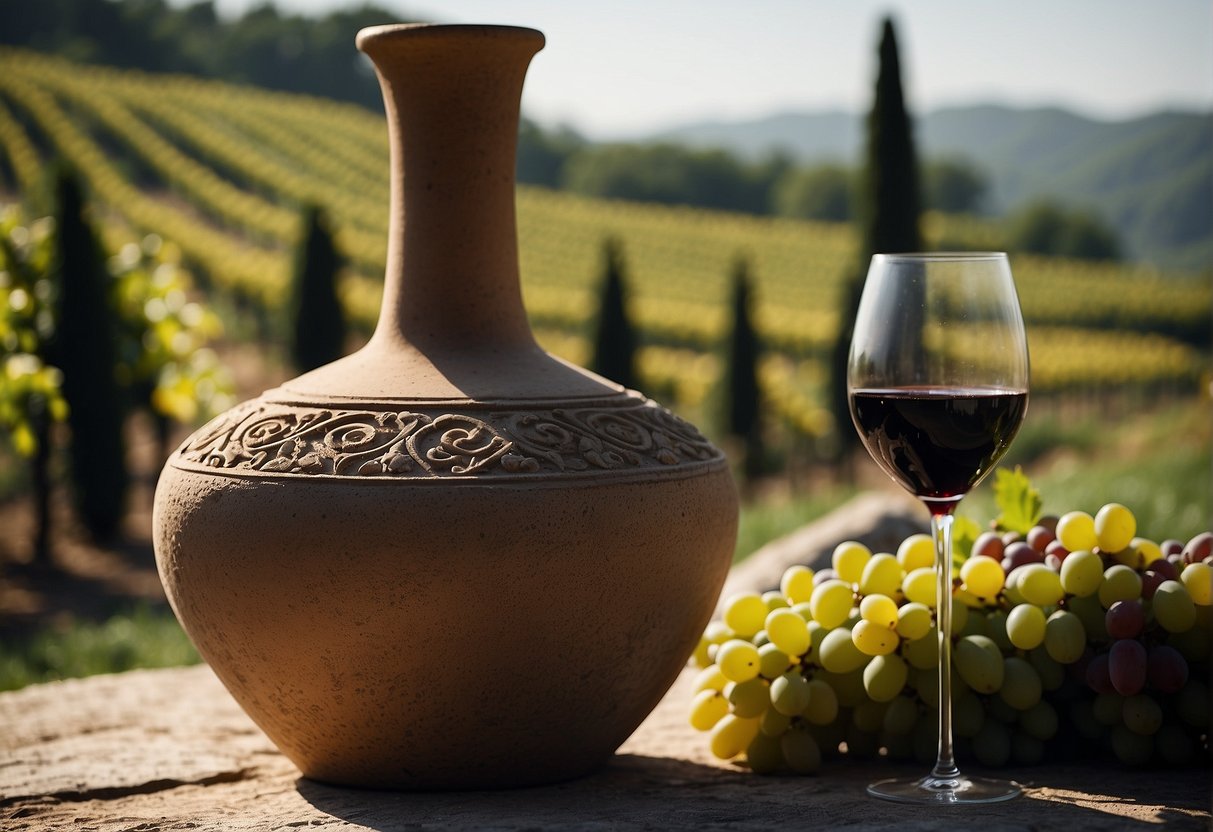
In the realm of oenology, understanding how ancient Roman wines compare to modern vintages reveals a world of difference in both production methods and flavor profiles.
Winemaking Evolution
The winemaking techniques during Roman times were rudimentary in comparison to the sophisticated processes behind modern wine production.
Ancient Romans lacked the knowledge of microbiology that today guides the fermentation process.
Contemporary winemakers can control fermentation temperatures and employ specific yeast strains to influence the sensory profile of their wines.
They produce diverse wines, including red wine, white wine, and orange wines, with precision and consistency.
This controlled environment contrasts with ancient methods, where wine fermentation occurred in open vessels, leading to less predictable results.
Sensory Differences
Wine tasters would likely encounter a stark contrast between the flavor of Roman wine and that of today’s reds and whites.
Roman wines were often flavored with additives, such as herbs and resins, to mask spoilage, which would have significantly altered their sensory profiles.
In contrast, the flavor notes of modern wines are attributed to the grape’s characteristics and the winemaking process.
The taste of Roman wine had a propensity to be more robust and less refined, whereas contemporary wine is celebrated for its subtlety and broad range of flavors, from the bold tannins in reds to the crisp acidity in whites.
Scientific Studies and Archaeological Findings
The investigation into the taste of Roman wine combines chemical analysis with archaeological evidence. Scholars utilize remnants of ancient amphorae and other artifacts to infer the wine’s properties, while also applying modern scientific techniques to understand its chemical composition.
Chemical Composition and pH
Studies focusing on the chemical composition of residues found in ancient Roman wine containers have provided insights into the acidity and pH levels of Roman wine.
By analyzing tartaric acid and other organic compounds, researchers have reconstructed aspects of the wine’s flavor profile and fermentation process.
For instance, a study by scientists revealed that Roman wines likely had a higher acidity compared to modern wines, due to the cooler fermentation temperatures and the local grape varieties used.
Archaeological Excavations and Discoveries
In Pompeii, archaeologists like Paulina Komar from the University of Warsaw and Dimitri Van Limbergen from Ghent University have unearthed evidence of wine production such as carbonized grape seeds and marks of vine poles.
These discoveries, published in journals such as Antiquity and covered by outlets like Newsweek, enable researchers to piece together the vinicultural practices of the Romans.
Archaeological findings suggest that the wines were often stored and aged, which would have influenced their taste, much like the aging process does today.
Cultural Significance and Social Aspects
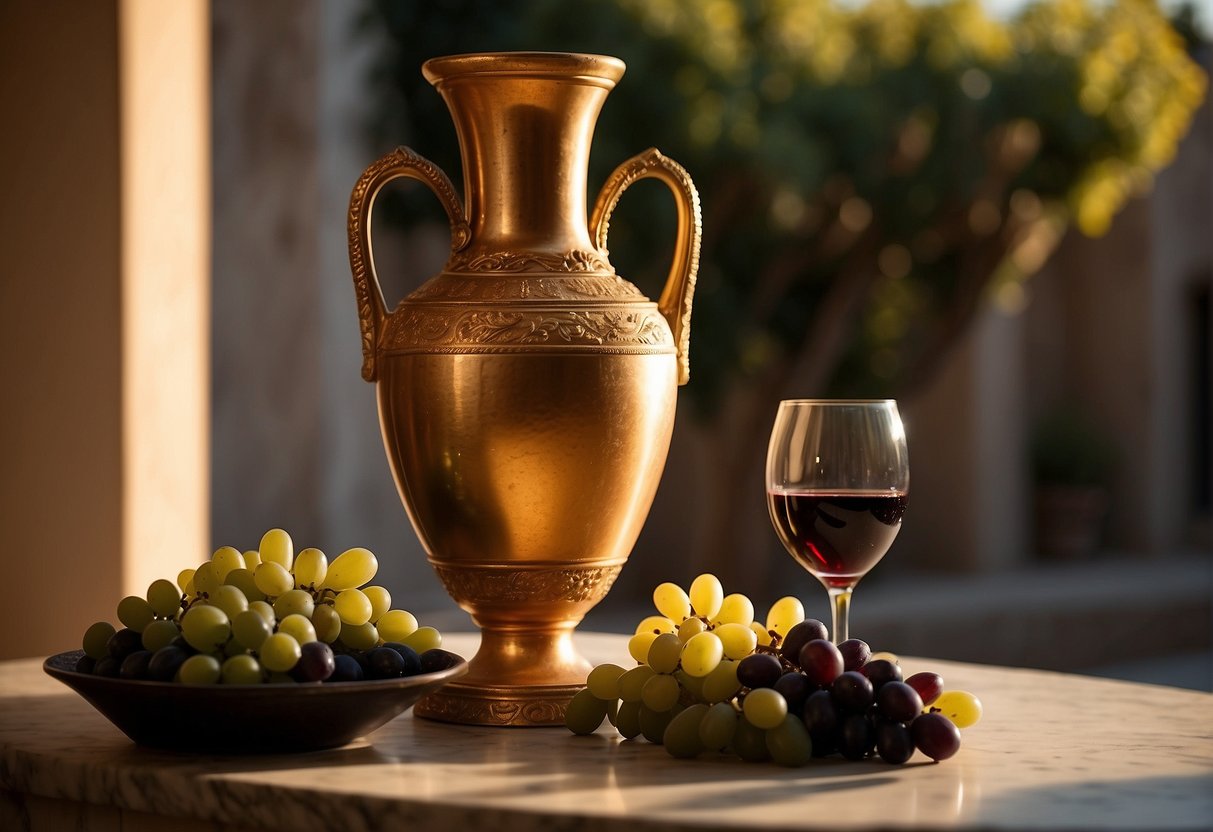
Wine held a prominent role within ancient Roman society, deeply entwined with daily living, culture, and religious practices. It was more than a beverage; it was a symbol of prosperity and piety, a staple on the tables of everyday Roman homes.
Wine in Daily Life and Cuisine
In ancient Rome, wine was not merely a luxury; it infused the very fabric of daily life and cuisine. For many Romans, wine was a staple, as essential as grain and olive oil. It graced the tables of both the rich and the poor, and was often mixed with water to ensure its suitability for all, from the high-born senators to the common folk.
The presence of wine cellars in Roman villas signifies its importance and the sophistication of the wine industry at the time. Wine played a crucial role in both food and social settings. It was often diluted and flavored with herbs and spices, showcasing its integration into Roman culinary practices.
Symbolism and Religious Importance
The symbolic weight of wine was paralleled by its religious significance. Romans personified wine in the form of Bacchus—the god of agriculture, wine, and fertility—underpinning the drink’s divine status.
Various ceremonies and festivals like the Bacchanalia celebrated the deity, reflecting wine’s deep spiritual resonance. It acted as a libation in religious rituals, a holy offering to deities, a means to commune with the divine.
At feasts and public events, the communal sharing of wine further solidified its position as a substance that could bridge the gap between mortals and gods, elevating its status beyond that of a mere consumable.
Conservation and Restoration Efforts
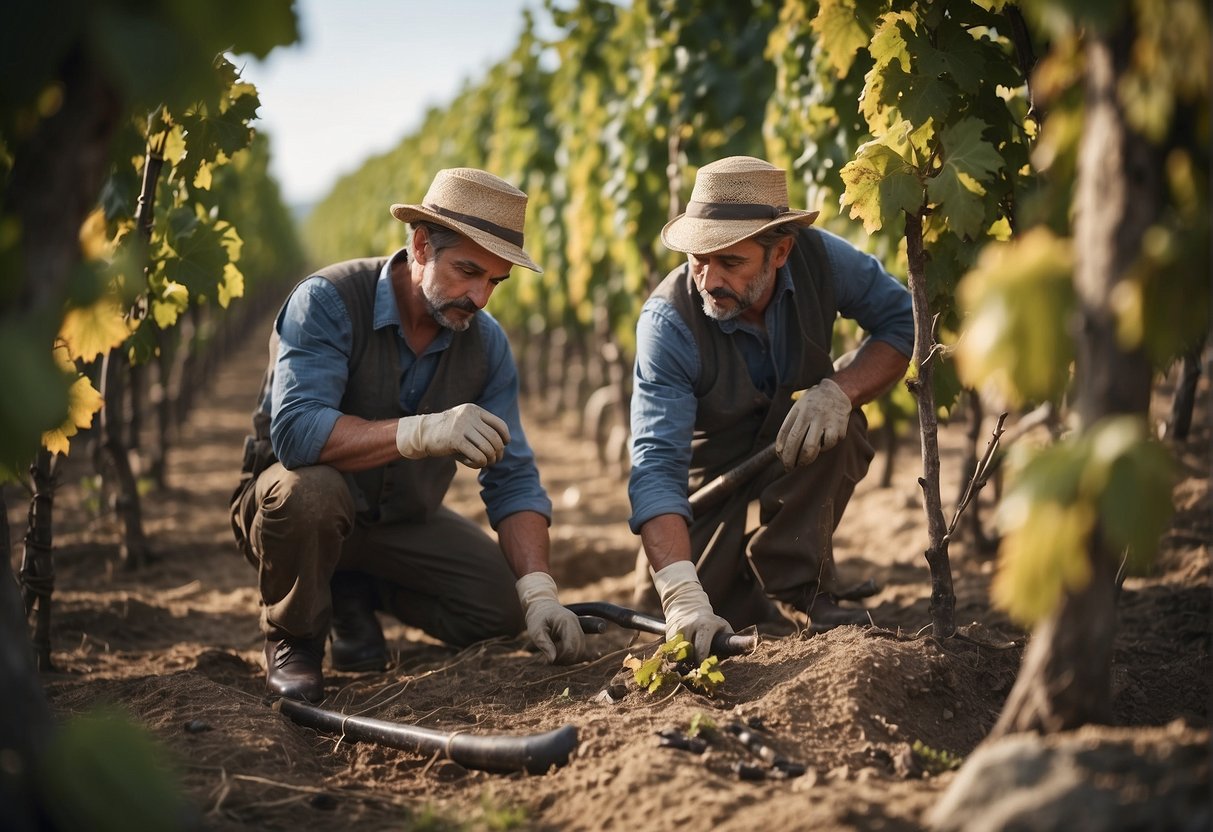
Conservation and restoration efforts are essential for understanding the rich history of winemaking in the Roman Empire. These initiatives enable experts to piece together how ancient Roman wine was produced, stored, and enjoyed.
Preserving Ancient Winemaking Artifacts
Archaeologists have unearthed numerous artifacts, including pottery shards and amphorae, which provide insights into Roman winemaking.
These items are meticulously conserved, with efforts prioritizing both structural integrity and preventing further deterioration.
For instance, in Pompeii, where many ancient wineries were preserved under volcanic ash, rigorous conservation methods have safeguarded the delicate remains. Techniques include climate-controlled displays and the use of specialized consolidants to stabilize porous ceramic materials.
Recreating Historical Wine Varieties
Recent studies have focused on recreating historical wine varieties that were once popular in the Roman era.
This ambitious task involves analyzing ancient texts, botanical remains found in archaeological sites, and even residue analysis from recovered amphora to identify grape varieties and winemaking techniques.
In Georgia, often dubbed the ‘cradle of winemaking,’ researchers attempt to revive ancient viticulture practices. These efforts not only shed light on the taste of Roman wine but also support the conservation of agricultural biodiversity.
Glossary of Roman Winemaking Terms
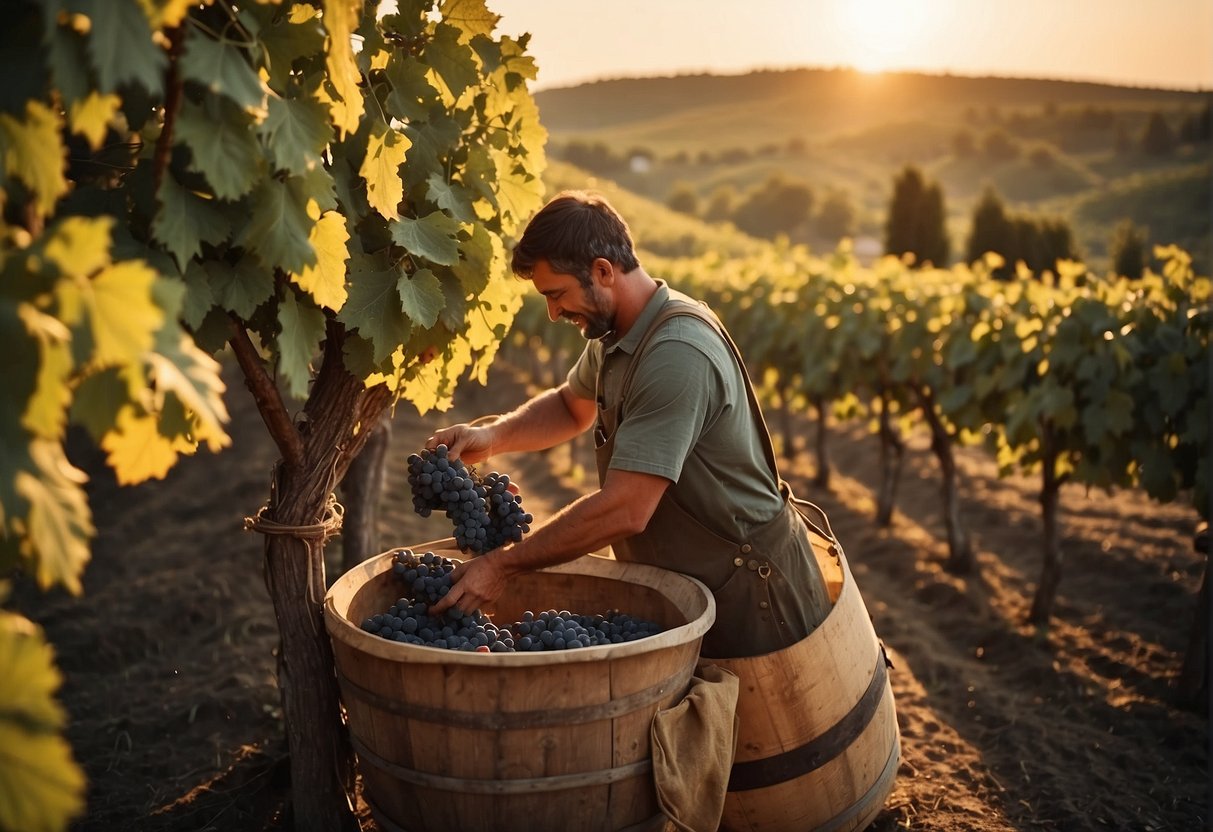
In the realm of ancient Roman winemaking, a variety of specific terms were employed to describe the meticulous process from vineyard to vessel. This glossary provides a succinct overview of key terms:
- Dolia: Large clay pots embedded in the ground, used by the Romans for fermenting wine. They were the precursors to modern-day wine vats.
- Fermentation: The chemical transformation of grape juice into wine, driven by the action of yeasts on sugars, resulting in the production of ethanol (alcohol) and carbon dioxide.
- Maceration: The process where the grape skins and solids are left in contact with the fermenting juice, imparting color, flavor, and tannins to the wine.
- Amphora: Ceramic vessels with two handles and a long neck, amphorae were used for storing and transporting wine. Their distinct shape and material helped in maintaining the temperature during transportation.
- Flor Yeasts: A type of yeast that forms a layer on top of the wine, which was likely not a known term in ancient Rome, but a process akin to the modern understanding might have been observed with wines exposed to air.
- Qvevri: While more commonly associated with ancient Georgian winemaking, these large, earthenware vessels were similar to Roman dolia and used for fermentation, aging, and storage of wine, buried in the earth to maintain a constant temperature.
Frequently Asked Questions
The fascination with Roman wine stems from its historical significance and distinct production methods. These FAQs explore its unique characteristics and role in ancient Roman culture.
What were the main characteristics of wine in Roman times?
Roman wines were diverse, with varied flavors that often included a combination of sweetness, strength, and occasionally a higher level of acidity. Many were robust and unfiltered, bearing a notable difference to modern wines’ clarity and taste.
How did the taste of Roman wine differ from today’s wine?
Wines from Roman times typically had a thicker consistency and were less refined than today’s variants. Romans often flavored their wine with herbs and spices, leading to a taste profile markedly different from the clean, fruit-forward flavors of contemporary wines.
What ingredients did Romans add to their wine?
Romans were known to add a range of ingredients to wine, including spices, honey, and sometimes seawater, to enhance flavor and longevity. This practice created a distinctive taste not commonly found in modern wine production.
What types of wine were commonly consumed in ancient Rome?
Ancient Rome saw the consumption of various wines, from the light and delicate to the strong and heavy. There were also special wines like mulsum, a honeyed wine, and conditum, a spiced concoction, enjoyed for particular occasions.
In what ways was wine used in Roman society?
Wine in Roman society transcended mere consumption; it acted as a dietary staple, a social lubricant, and an offering to the gods. It was integral to public feasts, private gatherings, and religious ceremonies, underscoring its cultural importance.
What methods did Romans use to produce their wine?
The Romans employed various methods in wine production. They used manual grape pressing and aged wine in large clay vessels called amphorae. They understood the value of terroir and storage, although they approached these concepts differently than in modern enology.
